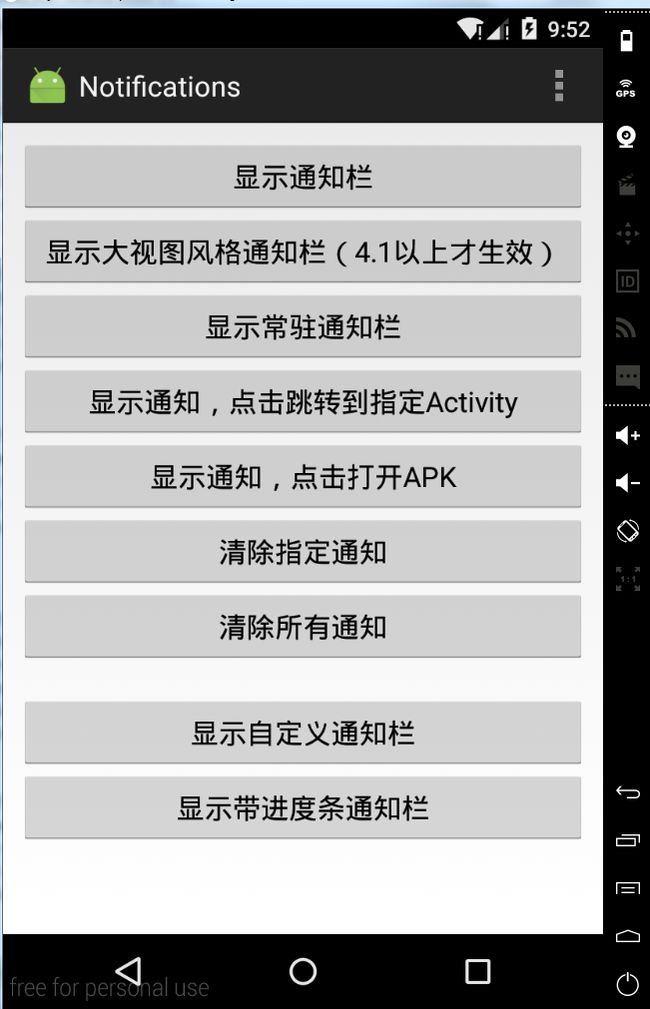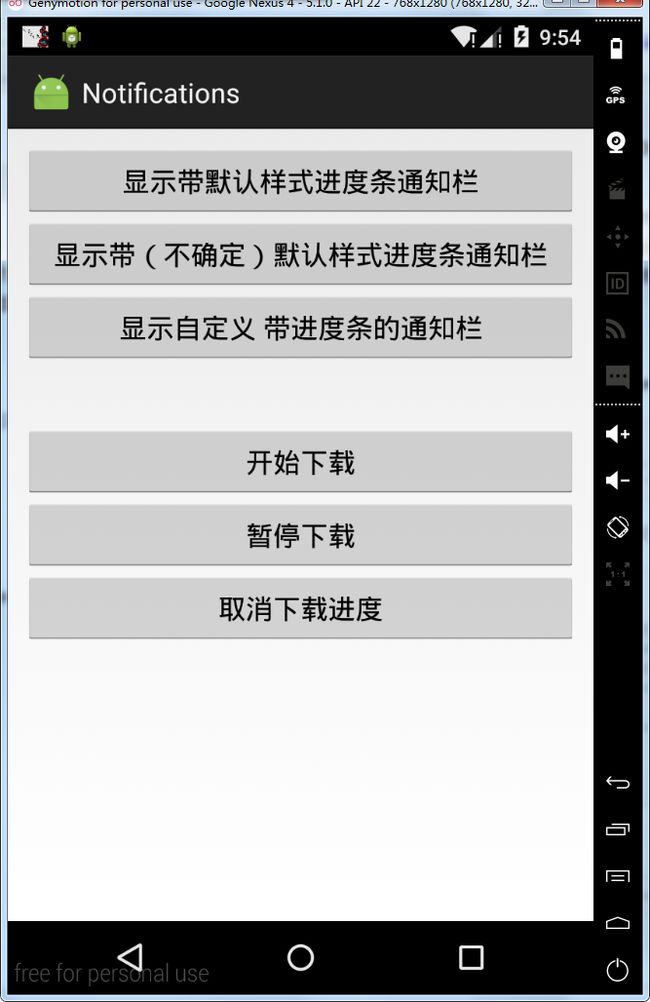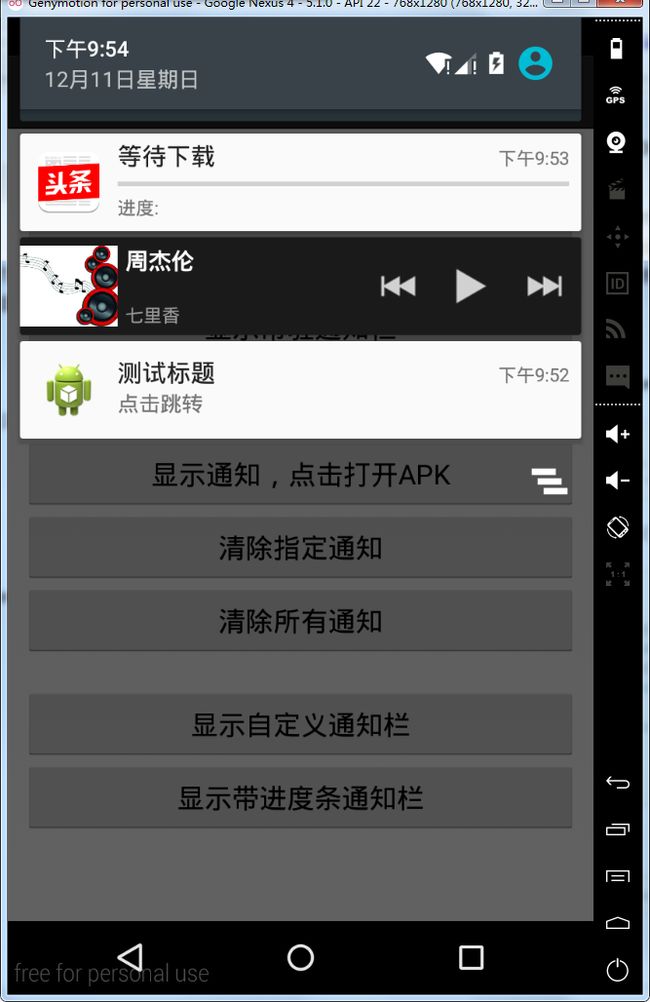使用Notifaction和NotifactionManager的目的
Broadcast Receiver组件并没有提供可视化界面来显示广播信息,而Notifaction和NotifactionManager可以实现可视化的信息显示,通过它们可以显示广播信息的内容以及图标和震动等信息(在状态栏上)
具体步骤:
1)获得系统级的服务Notification Manager,调用getSystemService()方法实现
//创建一个NotificationManager的引用
String ns = Context.NOTIFICATION_SERVICE;
NotificationManager mNotificationManager = (NotificationManager)getSystemService(ns);
2)然后实例化Notification,设置其属性(要显示的)
//实例化Notification
n = new Notification();
//设置显示图标,该图标会在状态状态栏显示
int icon =n .icon=R.drawable.notification;
//设置显示提示信息,该信息会在状态栏显示
String tickerText="Test Notification";
//显示时间
long when = System.currentTimeMillis();
n .icon=icon;
n .tickerText=tickerText;
n .when=when;
当然也可以这样写
Notification n1 = new Notification(icon,tickerText,when);//图片,显示文字,时间
3)通过Notification Manager发出通知
//实例化intent
Intent intent = new Intent(MainActivity.this,MainActivity.class);
//获取pendingIntent
PendingIntent pi = PendingIntent.getActivity(MainActivity.this, 0, intent, 0);
//设置事件信息
n.setLatestEventInfo(MainActivity.this, "My Title", "My Content", pi);
//发出通知,把Notification传递给 NotificationManager
mNotificationManager .notify(ID,n);
取消提醒
mNotificationManager .cancel(ID);
使用自定义的 Notification
要创建一个自定义的Notification,可以使用RemoteViews。要定义自己的扩展消息,首先 要初始化一个RemoteViews对象,然后将它传递给Notification的contentView字段,再把PendingIntent传递给 contentIntent字段。
1)创建一个自 定义的消息布局。
2)在程序代码中使用RemoteViews的方法来定义image和text。然后把RemoteViews对象传到contentView字段
RemoteViews contentView=new RemoteViews(getPackageName(),R.layout.view);
contentView.setImageViewResource(R.id.image,R.drawable.icon);
contentView.setTextViewText(R.id.text,”Hello,this message is in a custom expanded view”);
notification.contentView = contentView;
3)为Notification的contentIntent字段定义一个Intent(注意,使用自定义View不需要 setLatestEventInfo()方法)
RemoteViews contentView=new RemoteViews(getPackageName(),R.layout.view);
contentView.setImageViewResource(R.id.image,R.drawable.icon);
contentView.setTextViewText(R.id.text,”Hello,this message is in a custom expanded view”);
notification.contentView = contentView;
4)发送通知
mNotificationManager.notify(ID,notification);
大体步骤就是这些,下面是一些属性。
//初始化 Nofification
Notification notification =new Notification(icon,tickerText,when);
/*
* 添加声音
* notification.defaults |=Notification.DEFAULT_SOUND;
* 或者使用以下几种方式
* notification.sound = Uri.parse("file:///sdcard/notification/ringer.mp3");
* notification.sound = Uri.withAppendedPath(Audio.Media.INTERNAL_CONTENT_URI, "6");
* 如果想要让声音持续重复直到用户对通知做出反应,则可以在notification的flags字段增加"FLAG_INSISTENT"
* 如果notification的defaults字段包括了"DEFAULT_SOUND"属性,则这个属性将覆盖sound字段中定义的声音
*/
/*
* 添加振动
* notification.defaults |= Notification.DEFAULT_VIBRATE;
* 或者可以定义自己的振动模式:
* long[] vibrate = {0,100,200,300}; //0毫秒后开始振动,振动100毫秒后停止,再过200毫秒后再次振动300毫秒
* notification.vibrate = vibrate;
* long数组可以定义成想要的任何长度
* 如果notification的defaults字段包括了"DEFAULT_VIBRATE",则这个属性将覆盖vibrate字段中定义的振动
*/
/*
* 添加LED灯提醒
* notification.defaults |= Notification.DEFAULT_LIGHTS;
* 或者可以自己的LED提醒模式:
* notification.ledARGB = 0xff00ff00;
* notification.ledOnMS = 300; //亮的时间
* notification.ledOffMS = 1000; //灭的时间
* notification.flags |= Notification.FLAG_SHOW_LIGHTS;
*/
/*
* 更多的特征属性
* notification.flags |= FLAG_AUTO_CANCEL; //在通知栏上点击此通知后自动清除此通知
* notification.flags |= FLAG_INSISTENT; //重复发出声音,直到用户响应此通知
* notification.flags |= FLAG_ONGOING_EVENT; //将此通知放到通知栏的"Ongoing"即"正在运行"组中
* notification.flags |= FLAG_NO_CLEAR; //表明在点击了通知栏中的"清除通知"后,此通知不清除,
* //经常与FLAG_ONGOING_EVENT一起使用
* notification.number = 1; //number字段表示此通知代表的当前事件数量,它将覆盖在状态栏图标的顶部
* //如果要使用此字段,必须从1开始
* notification.iconLevel = ; //
*/


